Learn: Diamonds > Clarity
Introduction
Transparency
Clarity
Internal Graining
Myth
Surface Graining
Eye Clean
Twinning
Clarity Characteristics
Artificial Intelligence & Clarity Grading
Flaws & Cracks
Clarity Myths & Facts
1. Flawless diamonds sparkle the most:
False. Most VS and SI diamonds sparkle more than most flawless diamonds
2. It’s best to buy an ‘eye clean’ SI or I1 diamond:
Wrong. The diamond will likely be dull and cloudy
3. GIA has two or three graders that decide the clarity grade:
Ancient History: AI is taking over
Google search definition of Clarity:
the quality of transparency or purity
“the crystal clarity of water”
Clarity is all about ‘purity’ and sadly ignores transparency
Read on for all the answers
Clarity
It’s not just the carat weight that influences how much you’ll have to splurge on a diamond, the next big factor pushing the cost of a diamond upward is its clarity. There are three factors that we need to discuss and consider:
- Inclusions: Some inclusions you can see, some you can’t. Of course, you don’t want to see inclusions or flaws, which is our next consideration.
- Flaws can mean your diamond could break. Yes, that’s a possibility too as diamonds often have cracks. GIA and labs call cracks ‘feathers’.
- Labs do not give a grade for a diamond’s transparency. What they really do is conceal the diamond’s transparency with clarity grade jargon such as ‘Clouds’ and ‘Internal Graining’.
There is no such thing as a flawless diamond!
MYTH Flawless diamonds sparkle the most.
Many people believe that clarity has a direct relationship with a diamond’s ability to sparkle.
That is both wrong and an oversimplification. Most diamonds with very slight and slight inclusions sparkle just as well as flawless and VVS diamonds.
Sparkle is a factor in the cut quality and the transparency of the diamond.
To achieve a flawless diamond often the cutter compromises the cut quality to remove all inclusions.
Clarity is another constraint to cut quality.
In SI diamonds we prefer to have a single almost visible inclusion, or a few black spots because that is an ‘honest’ SI diamond. Not a sneaky stone with brilliance reducing inclusions. Close to the edge can be good if a claw can cover the inclusion, but right on the edge may become a chipping hazard. ‘Experts’ may advise you to avoid a diamond with an inclusion in the center, but a table inclusion will be about 2/3rds the size of an equivalent inclusion in the outer or crown facets.
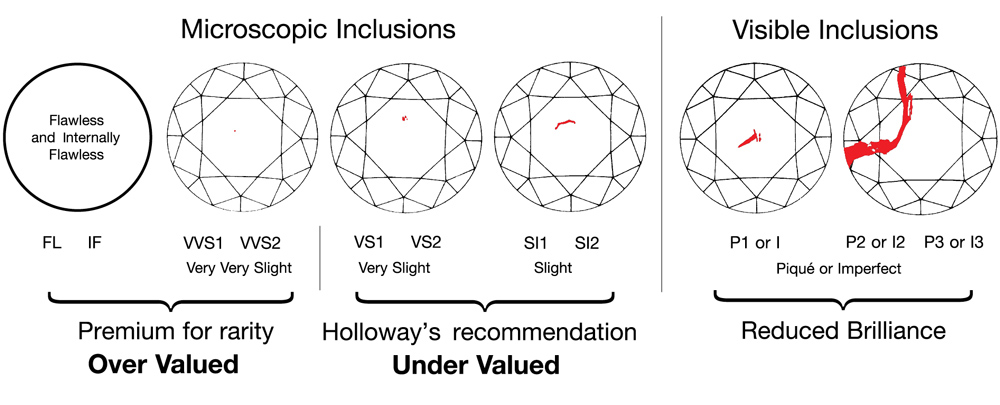
Mind Clean some people will seek out Flawless diamonds because they want perfection or “purity” that a diamnond stands for. However, it is just a “mind thing” as at higher magnification than 10X there are no flawless diamonds.
I believe most people want a bigger “eye clean” diamond, i.e., no visible inclusions seen with the naked eye (with exceptional cut quality and perfect transparency).
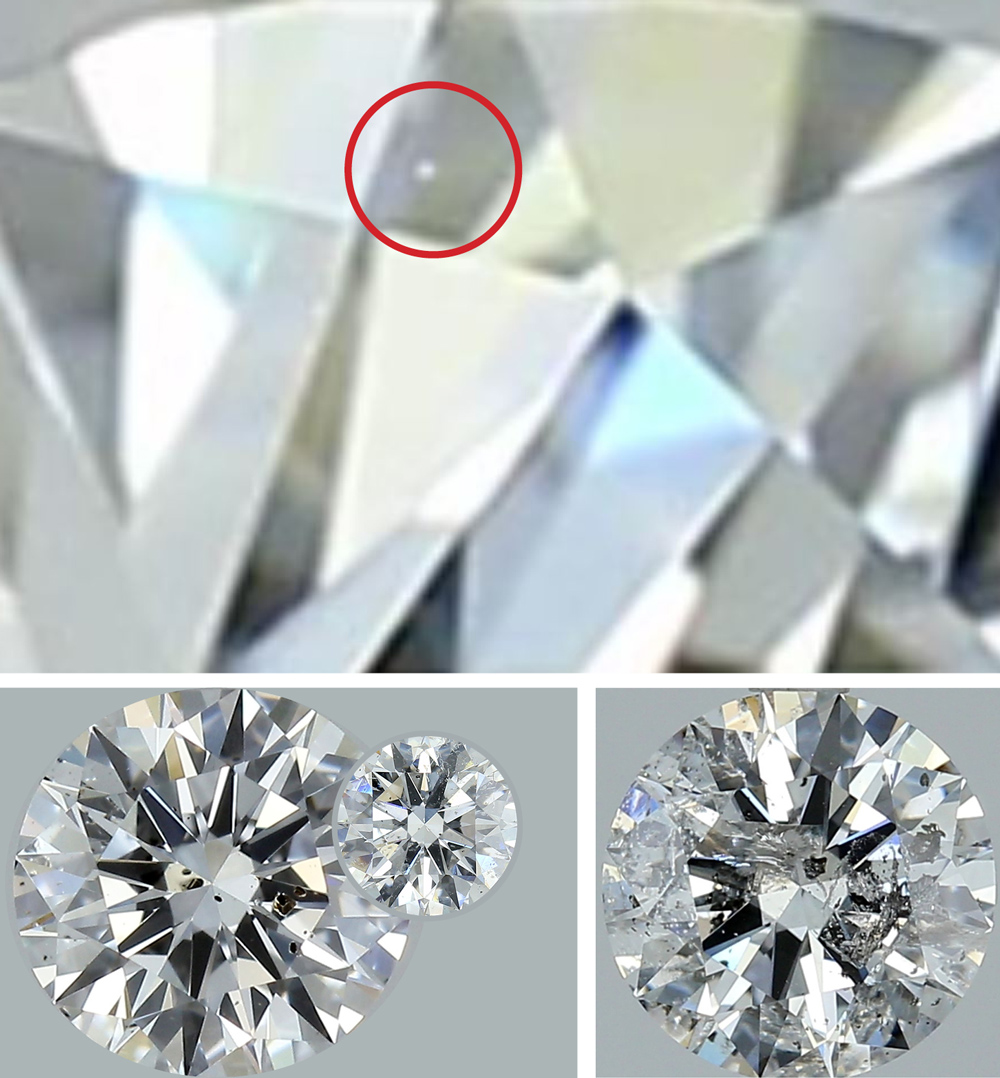
Top: VVS1 Same size in any carat weight diamond
Left: Inclusions in this 4ct 10.2mm SI2 are much easier to see than in this 0.50ct 5.1mm SI2 that is half the size
Right: 3 inclusions cover about half the diamond. Hard to see in a tiny stone, huge in a big rock!
Eye Clean
If you want the best value eye-clean diamond – stick to the Very Slight (VS) range for larger diamonds. For smaller diamonds, smaller than say half a carat, you may very well drop to the Slightly Included (SI) grade. That’s because the inclusion size is graded as if it were a percentage of the diamonds’ size in lower clarity grades.
Clarity grading is actually a complex mix of two different systems. The system developed over more than a century and is essentially a flawed grading methodology. The boundary between Internally Flawless (IF) and Very Very Slight (VVS1) is graded on the size of the inclusion, irrespective of the diamond’s size, it must be smaller than 5 microns (0.005mm) to be flawless. A VVS1 grade is the same for a 0.25ct diamond as it is for a 250ct diamond. At the low end of the scale, inclusions are graded based on the area they occupy (and their darkness and the durability of the stone). VS and SI grades are smack bang in the middle of these two systems. While this might not make sense, it’s how the system has evolved. A very small 0.10ct I2 diamond might be ‘eye-clean. A 10ct I2 diamond can have eye-visible inclusions from across a dinner table.
Clarity Characteristics
GIA and some other labs list clarity characteristics in order of worst to the least important for the assigned grade. These are listed on the clarity plot on full reports under the heading Key to Symbols. GIA Dossier reports do not have clarity plots, however, they do list the characteristics. The ‘grade maker’ is the first listed.
The importance of the inclusions listed here is closely linked to the clarity grade itself. Dropping one clarity grade, say from VS1 to VS2, roughly correlates to a doubling of the size or number of inclusions. This means of course that there are better and worse clarities within a grade. Add to this, a grade like SI2 has a far broader range than a VVS2.

Diamonds are about ten times harder than ruby and sapphire, the next hardest mineral. But they are not impossible to chip if you hit the girdle edge or smash them with a hammer!
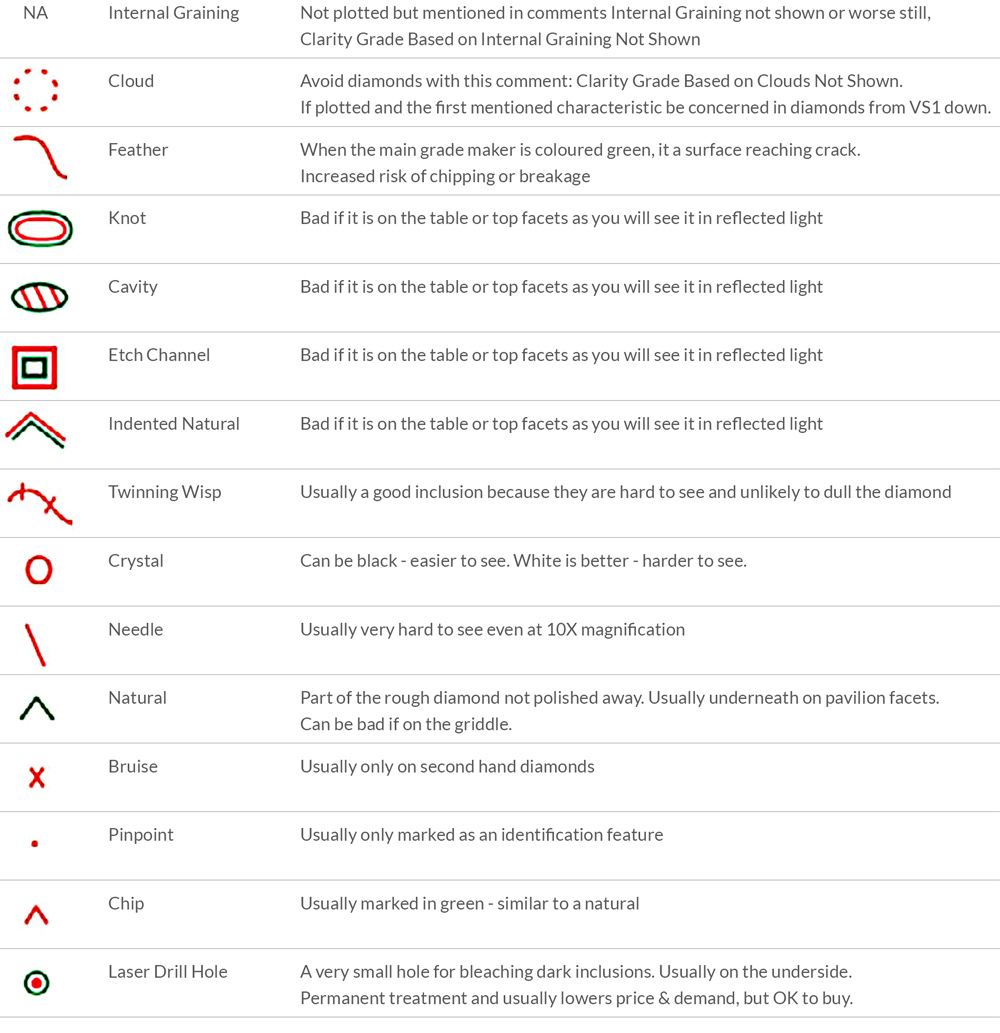
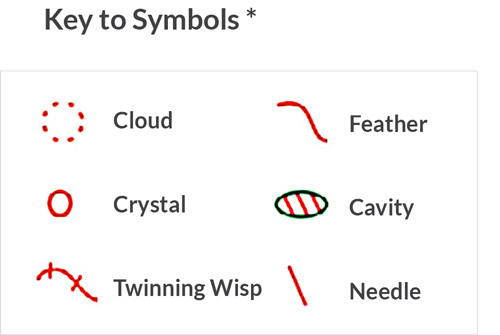
In this VS2 example there are 6 types of inclusion listed (that would be under an inclusion plot on a full report or text only on a smaller Dossier cert). If the Cloud was the only listed inclusion the diamond may be hazy or milky. However with so many other inclusions even with the Cloud as the ‘grade maker’ the Cloud is unlikely to reduce transparency. The needle would be hard to find with a loupe. In an SI2 such a stone may be milky or hazy.
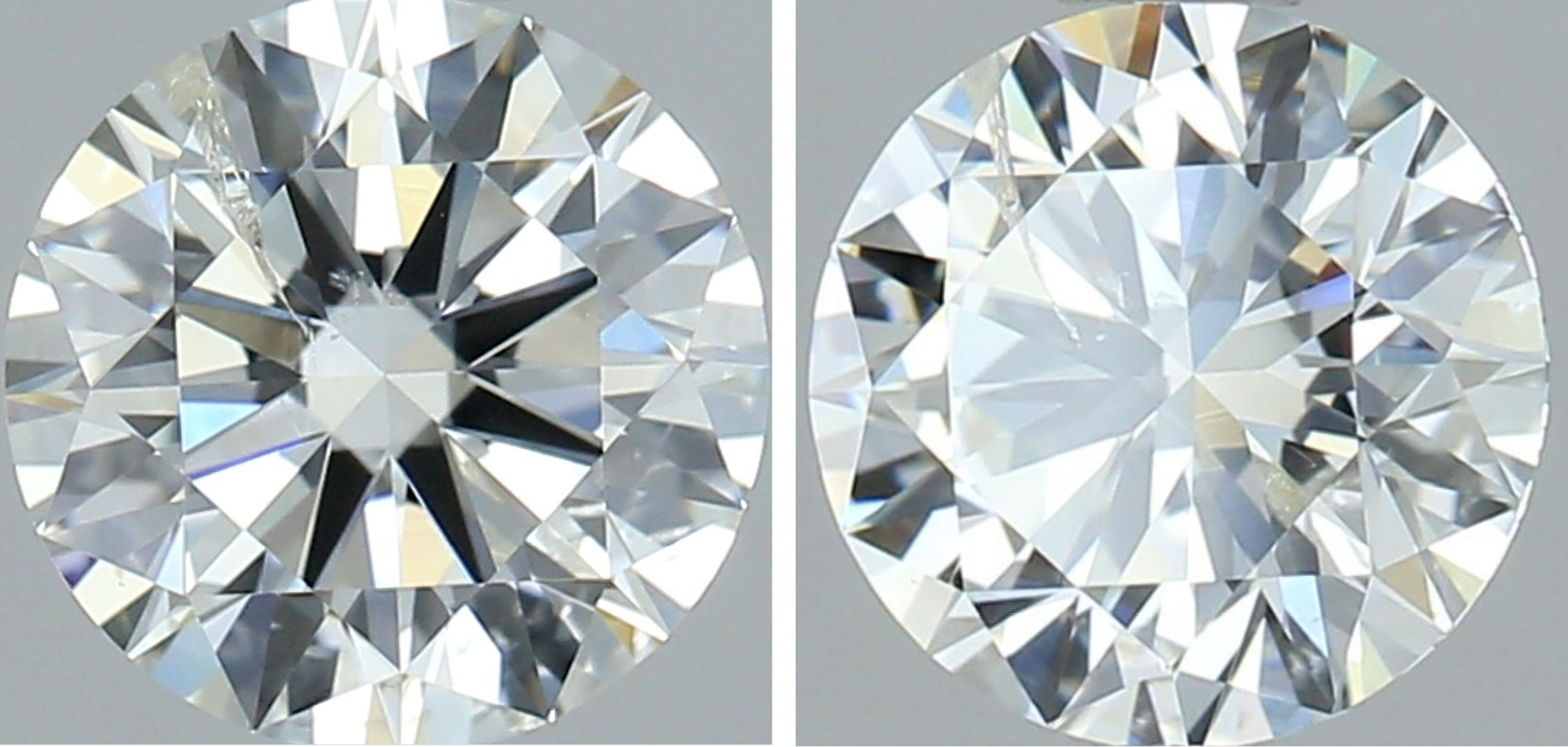
This I1 feather or crack running from upper left to the center of the diamond reaches the surface as can be seen in the tilted image on the right in reflected light.
Flaws and Cracks
A Feather as described by GIA – “General trade term for a break in a gemstone, often white and feathery in appearance.” “Feathers can be internal but also reach the surface of a diamond.” What does that mean to a layperson? That’s a crack or a flaw. A flaw means there is an increased chance of chipping or breaking the diamond if something hits it hard at just the right angle. When an inclusion breaks the surface as just a very thin line GIA still marks it as red. Only if there is a hole or a chunk missing do they mark it in green and red.
People have this false notion that diamonds don’t break. But let me tell you, if you place a diamond on an anvil and try to smack it with a hammer, it will smash into a million pieces.
Diamond is the hardest substance on Earth, only another diamond will scratch a diamond. So we need to draw a clear line of difference between a diamond’s scratch hardness and its smash hardness.
A good way to think about this is glass and steel. If you hit the piece of glass hard with a hammer, it’s going to smash. But take a shard of the broken piece of glass and it will easily scratch the hammer. So, you see, hardness and toughness are two completely different phenomena.
A feather marked on a diamond plot or mentioned on a Dossier can be OK or bad. If it’s on the underside or pavilion of the diamond, you don’t need to worry about it. The only person who can damage such a diamond is the jeweler who’s setting it – if he drops a tool on it, that might be a problem.
How does GIA grade these diamonds? They pay due attention to the risk of breakage of the diamond. So if a diamond has a big feather that reaches the girdle (edge of the diamond), they’ll grade the diamond more harshly than if the feather was in the pavilion side only.
If the feather is extremely small confined to one of the crown facets, it’s going to be significantly less risky than if it ran across the crown and onto the table facet, or if a large feather is smack bang in the middle of the table. Even if the diamond is perfectly eye-clean, the GIA may grade such a diamond as an I1. Softer labs like HRD and IGI may grade the same diamond as SI2 or SI1.
GIA is doing a decent job grading feathers, but it would be better if they called them cracks or flaws rather than use jargon.
So what are the chances that a diamond will break because of a feather? We do come across ‘old mine cut’ diamonds with giant feathers (or calling a spade a spade, a crack, or flaw) and the diamond has survived for at least a century. If you’re going to wear the diamond as an earring or a pendant there’s a very slim chance of you damaging the diamond unless you’re a cage fighter.
The good thing about feathers is they are almost always white and often reflective, so they can even act as a free extra internal facet!
Transparency
GIA Clarity grades do not account for transparency. Instead, GIA (and other labs follow the leader) consider transparency as a factor in clarity grading. The problem with this is that GIA does not state in plain language the diamond has reduced transparency or is slightly dull, milky, or hazy. As a consumer, you might expect GIA would do as they claim, to protect you, the consumer!
You will never read – Cloudy, Hazy or Milky on a cert. GIA doesn’t call a spade a spade, and other labs follow their lead. Labs use of code words and jargon that helps the savvy folk in the trade keep consumers in the dark! It helps sell diamonds that might otherwise end up on a concrete saw blade.
Clouds and internal graining are the main culprits, but twinning (read below) sometimes causes problems too.
When the ‘grade maker’ is a Cloud or Internal Graining the diamond can be sold in a store under bright lighting, or in a video or photo online as a lucky find. A VS or SI diamond may appear to be flawless. There are plenty of bottom-feeding sellers offering these diamonds as bargains. Retailers tell consumers “GIA made a mistake” but in reality, GIA are very good at what they do, even if I do not agree with their systems, it is very hard to fault them on the consistency and accuracy of grading of over 4 million diamonds a year.
A Cloud in a 1-carat VS1 non-fluorescent diamond is less likely to reduce the sparkle and transparency than an SI2 grade making Cloud. Be on the lookout for a drop in the transparency of any diamond that appears to have very few inclusions for its assigned grade.
The GIA worst trick is to sneak jargon into the ‘comments section.
- “Clarity grade is based on clouds that are not shown”
- “Clarity grade is based on internal graining that is not shown”
From VS2 down, if there is only one grade maker mentioned and that is clouds or clouds not shown, or internal graining (which is never shown) with no other type of clarity factor mentioned or plotted – then be careful about buying such a diamond without expert advice. The diamond is almost certain to have a transparency issue.
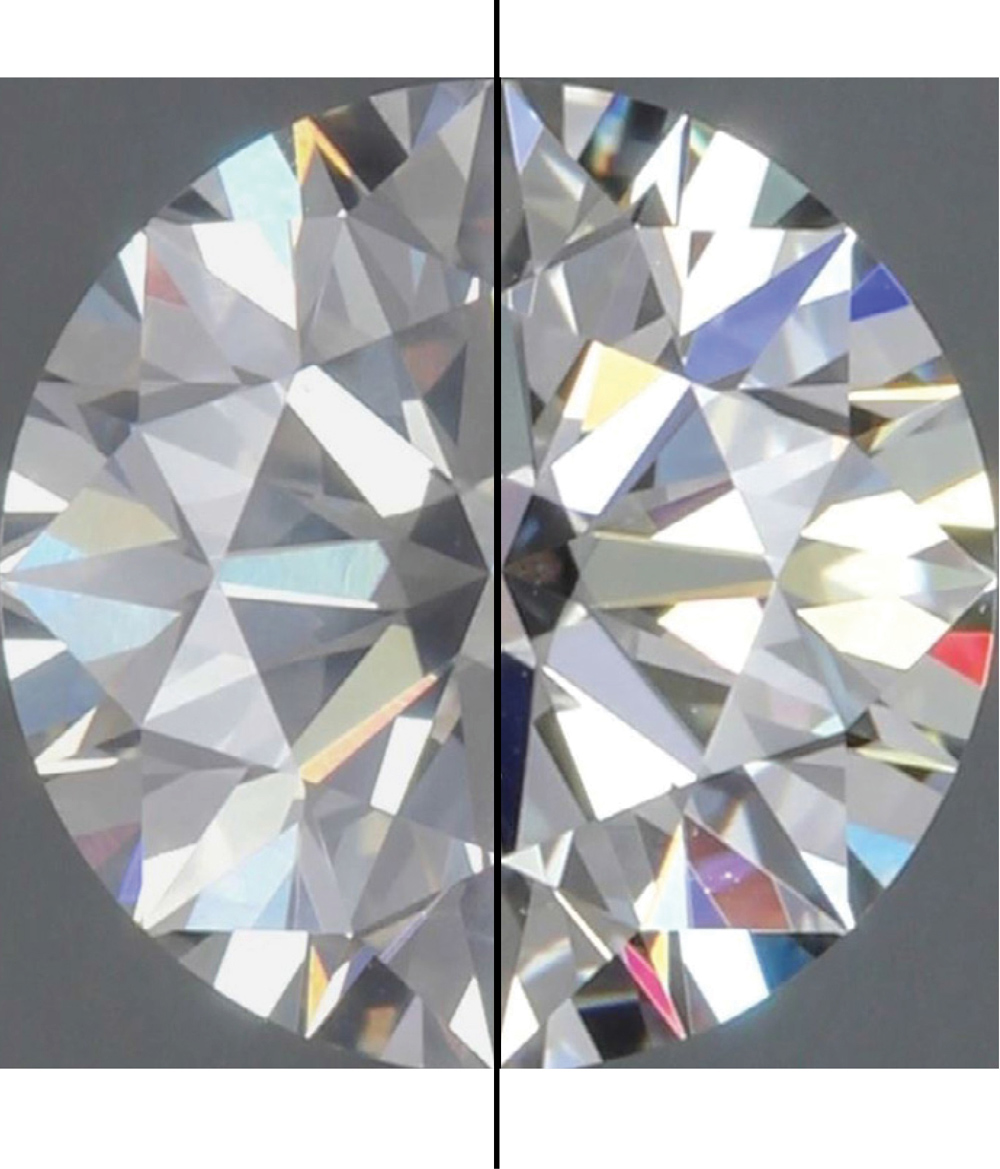
The left side is a half of a cloudy VS2 diamond that has no inclusions visible with a 10x magnification. The right half diamond has several small inclusions in the lower portion.
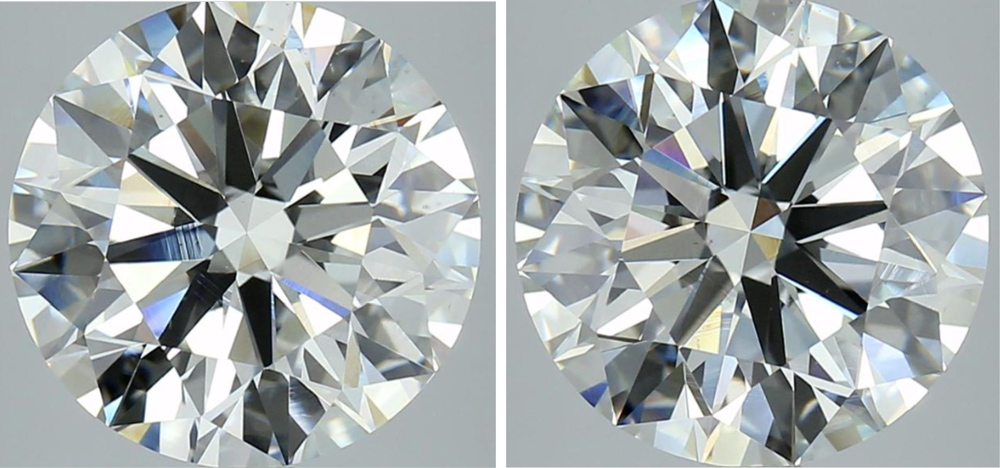
You can clearly see the graining left of the centre in the photo on the left. Tilting the diamond a few degrees and the grain lines disappear. GIA did not mention the Internal Graining on this diamonds grading report even though at 5ct it is visible to the naked eye.
INTERNAL GRAINING
Internal Graining are growth planes in a diamond and are most commonly white or greyish in a colourless diamond, but can be other colours such as the brown or pink grain lines in Argyle champagne and pink diamonds.
If the diamond is orientated so that you are looking straight down these planes you will see them as distinct lines as in the case of the diamond in the photo. Tilt the diamond a tiny bit and the graining simply disappears. Graining can reduce the diamond’s brilliance and GIA will make a comment “The Grade is Based on Internal Graining” when they consider it to dull the diamond’s brilliance and transparency. Worse still, if the stone is fluorescent then the combination will almost always reduce the diamond’s brilliance and it will appear hazy and milky. GIA has a rule of not plotting graining on a grading report, even when it is visible as in the diamond in the image here. Their policy is that because it comes and goes it is not relevant. Some good news, however, one of GIA’s researchers in September 2021 become aware of the interaction between fluorescence and clouds and graining and is pushing GIA to address transparency on its certs.
Internal graining is a common transparency issue in lab-grown or man-made diamonds.
Surface Graining
Surface Graining is a different matter. This occurs where a grainline (internally visible or not) meets the surface. Just like grain in timber, the different hardness can result in a tiny groove or ripple on the diamond’s surface. This is more common in fancy-shaped diamonds and may only be visible on a single facet in reflected light. It is rarely a problem and more of an identifying feature than a thing to worry about.
Clouds and internal graining should also be avoided in of medium or stronger fluorescent diamonds. The diamond will most certainly suffer reduced transparency in many lighting types.
TWINNING
Twinning is less likely than Clouds or Internal Graining to cause transparency issues and because most grading is done under a microscope with back lighting, it tends to be a winner for consumers. Twinning can also interact with fluorescence although it less of a problem than Clouds or Internal Graining.
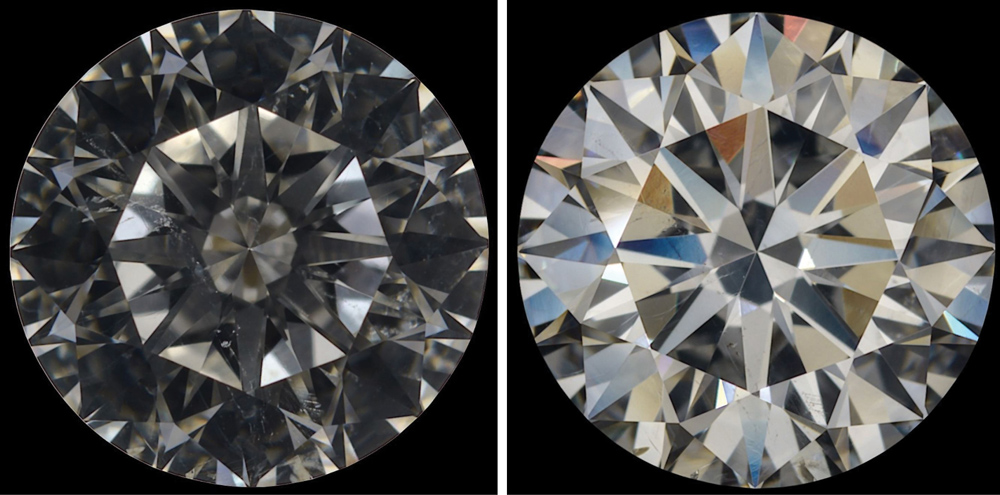
Left: A back lit microscope photo of a GIA graded SI2 diamond showing pronounced twinning.
Right: The same diamond in the left has been illuminated from above, note the twinning is less apparent. Lower right is an inclusion plot to assist in locating the twinning. (There are other unmarked inclusions not shown on this plot.) These images are from Cutwise.com
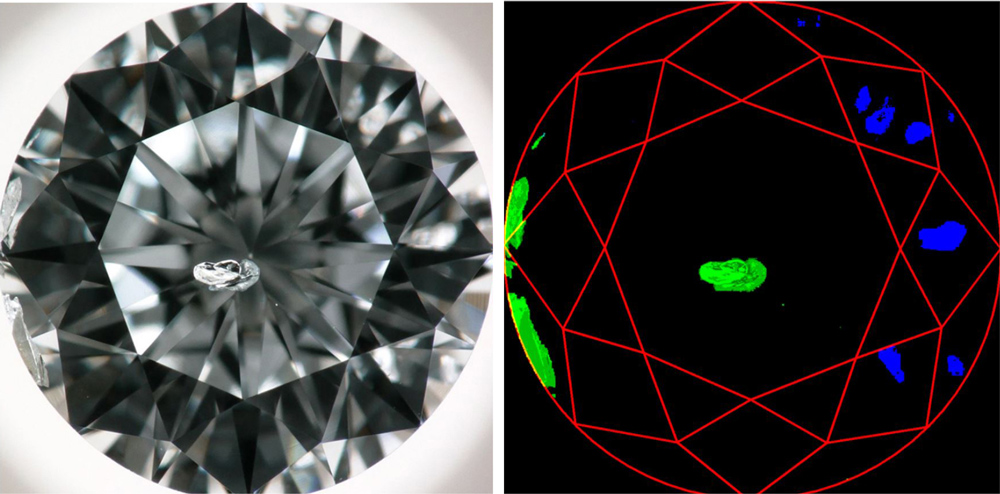
Artificial intelligence (AI) and clarity grading
In July 2020 GIA and IBM announced an agreement to work to automate clarity grading.
Pritesh Patel, Chief Operating Officer at GIA, explained: “We’ve brought a lot of different instruments into this industry over the years, and we solved the problems of cut, carat weight and color a long time ago. Clarity was the last frontier, and Artificial Intelligence (AI) was the key to conquering it.”
IBM Research and GIA agreed and began developing a strategic partnership. GIA will provide diamond imagery and data from tens of millions of diamonds examined by its diamond experts. IBM will provide AI capabilities and computing power. The goal GIA’s cloud-based AI approach to diamond clarity grading.
Evaluating the clarity of a diamond is a complex process. After IBM Research developed a successful proof of concept showing that AI can indeed help automate the diamond grading process, their Global Cloud Acceleration Team (GCAT) took over for the next stage. The GCAT team partnered with the GIA Engineering DevOps team to begin a production-ready environment with separate development, testing, production and disaster recovery clusters.
